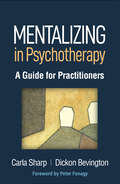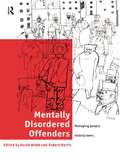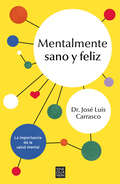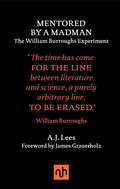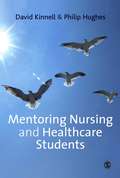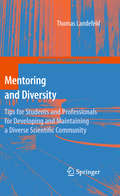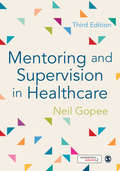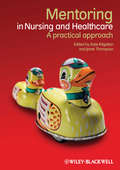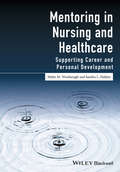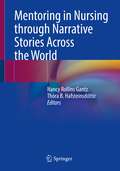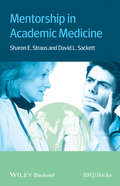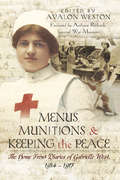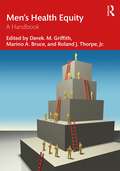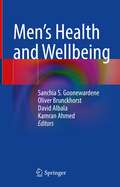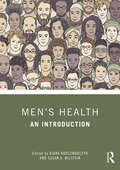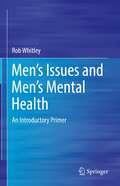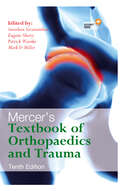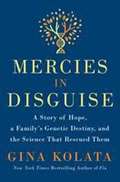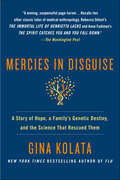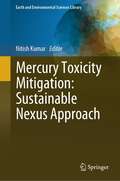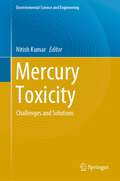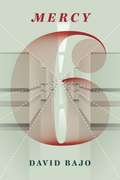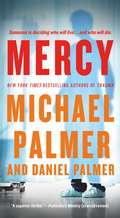- Table View
- List View
Mentalizing in Psychotherapy: A Guide for Practitioners (Psychoanalysis and Psychological Science)
by Dickon Bevington Carla SharpHow can therapists help clients reflect more deeply on their own--and other people's--thoughts and emotions? How can the therapeutic relationship be leveraged effectively to create change? This concise book guides therapists of any orientation to incorporate innovative mentalization-based strategies into assessment and intervention. Complex ideas are clearly explained and illustrated with extensive session transcripts and vignettes. Ways to help clients struggling with dysregulated emotions and behavior are highlighted. Compelling topics include the role of mentalization difficulties in personality disorders, special concerns in working with adolescents, and how clinicians can improve their own mentalizing capacities.
Mentally Disordered Offenders: Managing People Nobody Owns
by Robert Harris David WebbManaging the Mentally Disordered Offender presses the case for better health care of mentally disturbed law breakers, and the need to divert them from unnecessary imprisonment.Mentally disordered offenders present particular problems in our society, which wants both to sympathise and to punish. How do we get the balance right between sympathy towards their illness and genuine worries about their offending behaviour? What do we do for - and about - people wo have been released from prison yet we suspect continue to pose risks to the safety of others?With specialist contributors from criminology, criminal justice, social work, probation practice and the law, Managing the Mentally Disordered Offender stresses the importance of professional cooperation in community-based services, whilst acknowledgin the psychologically demanding nature of working with mentally disordered people, and ther very real challenges of attempting to contain their wrongdoing without recourse to the repressiveness of imprisonment.
Mentalmente sano y feliz: Mitos y realidades de la salud mental
by José Luis Carrasco Perera¿Qué es la salud mental y de qué manera está ligada a la felicidad? Una de cada cuatro personas sufrirá un trastorno mental a lo largo de su vida. La Organización Mundial de la Salud define la salud mental como un «estado de bienestar psíquico que permite a las personas hacer frente a los momentos de estrés de la vida, desarrollar todas sus habilidades, poder aprender y trabajar adecuadamente y contribuir a la mejora de su comunidad»En este libro, el doctor José Luis Carrasco -referente fundamental de la psiquiatría contemporánea- nos acerca, con un estilo divulgativo, a una de las grandes preocupaciones de la sociedad contemporánea: los trastornos psiquiátricos. El autor aporta, en un lenguaje sencillo, luz y claridad sobre los criterios de salud mental y felicidad, de las emociones, los pensamientos y de las relaciones personales desde el punto de vista médico, social e individual. «La salud mental no se alcanza siguiendo modas ideológicas, es más bien el fruto de unos fenómenos naturales que reducen el malestar y ayudan a tolerar el estrés, estimulando las habilidades mentales y relacionales. La salud mental está ligada a un bienestar más interno que externo y los consejos y las reflexiones contenidas en este libro pueden ayudar a conseguirla».
Mentored by a Madman: The William Burroughs Experiment
by A. J. Lees James GrauerholzA fascinating account by one of the world's leading neurologists of the profound influence of William Burroughs on his medical career. Lees relates how Burroughs, author of Naked Lunch and troubled drug addict, inspired him to discover a ground-breaking treatment for Parkinson's Disease. Lees journeys to the Amazonian rainforest in search of cures, and through self-experimentation seeks to find the answers his patients crave. He enters a powerful plea for the return of imagination to medical research.
Mentoring Nursing and Healthcare Students
by David Kinnell Philip Hughes"This key text offers mentors and students an insight into the relationship between mentorship theory, policy and practice." - Diane Tofts, Kings College London What does effective mentoring mean in actual practice? How can I be a good mentor? This book answers these questions and is designed to offer nursing and healthcare students a foundation in effective mentoring. Chapters examine the roles and responsibilities of the mentor, and how they enhance the process of mentorship. By examining the relevant competencies and knowledge base, the book provides an essential framework for developing the practice skills needed for successful mentoring. Key features include: - Embedded in real-life practice and case study examples - Offers tips for successful mentoring and reflects upon likely challenges - Features a range of interactive study activities linked to the student and mentor′s experiences - Presents the most up-to-date professional guidance - Includes running themes of reflective practice; evidence-based practice and multi-professional working. Mentoring Nursing & Healthcare Students will help both the mentor and the student to develop the skills needed for effective collaboration. It is the core text for mentor preparation and mentor update courses in nursing, midwifery and allied health.
Mentoring and Diversity
by Thomas LandefeldThis book will provide basic guidelines for facilitating the educational advancement of under represented students in the sciences, not only from the student perspective but also from the perspective of faculty advisors/mentors. Although the proper mentoring and advising of students about careers and preparation for the education and training associated with them is one of the most important components of a student's education process, this aspect has been severely lacking in academia in the past as well as the present. This is particularly the case with under represented ethnic minorities, despite the fact that mentoring of minority students has been identified as probably the most effective means for assisting them in achieving success. There are a multitude of reasons for this deficiency, including not enough mentors, students not "reaching out", lack of resources as well as other societal and academic limitations. This book provides tips to help guide a student on choosing mentors, what to expect from mentoring, and effectively developing a strong personal portfolio. Tips are also provided to scientists and faculty on being an effective mentor. The emphasis of the book will be primarily on students of color in the sciences, who are severely under represented, and will be presented in a "guidebook" format to simplify the process as much as possible.
Mentoring and Supervision in Healthcare
by Neil GopeeGopee (health and life sciences, Coventry U. , UK), who has worked in adult and mental health nursing, explores the standards, competencies, and outcomes for effective mentoring in nursing, midwifery, and other healthcare professions based on the UK's Nursing and Midwifery Council Standards to Support Learning and Assessment in Practice. He focuses on eight domain areas identified in the document and the outcomes for mentors, as he compares their role to others (such as clinical supervisors or practice education facilitators) and discusses key factors, personal and professional attributes, and the effects of poor mentoring. He describes how learning occurs and is facilitated; effective learning environments; activities such as evidence-based practice, research implementation, practice development, and management of change; assessing students' clinical competence; leadership; and the evaluation of mentoring. Annotation ©2012 Book News, Inc. , Portland, OR (booknews. com)
Mentoring and Supervision in Healthcare
by Neil GopeeThe Third Edition of this bestselling text continues to combine discussion of the theory and research which defines mentoring in healthcare with a sharp focus on how to do mentoring in practice. Key features of the Third Edition are: · discussion of the latest policy including the Francis Report and 6 Cs of nursing · a companion website with teaching resources for lecturers and expanded case studiesand free SAGE journal articles for students · activities which challenge readers to question their knowledge · example tools for mentors to use in practice, such as learning contracts, lesson plans and professional development plans. The book has been updated with the latest evidence and includes expanded discussions on coaching, working with underachieving students and supporting students with disabilities and special educational needs. Interprofessional in scope, it is essential reading for all those taking mentoring courses in nursing, midwifery, social care and the allied health professions.
Mentoring in Nursing and Healthcare: A Practical Approach
by Janet Thompson Kate KilgallonMentoring in Nursing and Healthcare is a practical, interactive resource that promotes active participation and enhances a deeper level of understanding of mentorship. It explores what is meant by the process of mentoring, addresses what a mentor is, what the role entails, and gives practical help on teaching and assessing students in clinical practice. Written primarily for mentors, this book offers a range of theoretical and practical activities and resources that are enhanced by online learning resources. Each chapter focuses on a different aspect of mentorship, including: The role of mentorship The mentor-student relationship The mentor as teacher Experiential learning and reflective practice Learning styles and teaching theories The mentor as assessor Competence and capability Health improvement Career development A core text for mentor preparation and mentor update courses in nursing and allied health, Mentoring in Nursing and Healthcare is an essential guide that supports learning and ongoing professional development. Key Features: Includes not only the latest and most up-to-date NMC standards, but also the Health and Care Professions Council's standards of proficiency Accessible and practice-oriented, with case studies, reflective exercises and activities throughout Has a strong focus on assessment skills Supported by interactive online resources that include test-yourself questions, multiple choice questions, web-links, PowerPoint slides, case studies, and activities at www.wiley.com/go/mentoring
Mentoring in Nursing and Healthcare: Supporting Career and Personal Development
by Helen M. Woolnough Sandra L. FieldenMentoring in Nursing and Healthcare: Supporting career and personal development is an innovative look into mentoring within nursing, and its implications for career success. It provides an up-to-date review of the current research and literature within mentoring in nursing and healthcare, drawing together the distinctive challenges facing nurses and their career development. It proposes new directions and practical ways forward for the future development of formal mentoring programmes in nursing. Offering fresh insight into mentoring principles and how these can be used beyond pre-registration nurse education to support personal career development. This is an essential book for all those commencing, continuing or returning to a nursing career. Key features: Addresses mentoring as a career development tool Focuses on the individual benefits of being a mentee and mentor and how this can aid professional development Both theoretical and practical material is presented Features case studies throughout book Supports nurses to develop their careers It is sector specific but has transferability across disciplines A summary chapter draws together common threads or theoretical perspectives. The book concludes with strategies for future research and progress
Mentoring in Nursing through Narrative Stories Across the World
by Thóra B. Hafsteinsdóttir Nancy Rollins GantzThe book explores how mentoring, theoretical background of mentoring and how mentoring is used by nurses in all arenas where they work in health care, education, research, policy, politics, and academia in supporting nurses with their professional and career development. Over 300 mentors and mentees, from a wide range of countries across all continents, share their stories of mentoring reflecting on their development in leadership, clinical practice, education, research and politics. The book describes various types of mentoring including more traditional types of mentoring as well as virtual, online and peer mentoring. During the mentorship trajectories the nurses address an inclusive collection of issues that they are faced with and share supporting strategies. The book highlights the importance of mentoring for nurses to support their personal, and professional leadership development. Also, it emphasizes the importance of mentoring for when nurses engaged in variety of projects that could entail or encompass evidence-based clinical practice, development within education, research in the clinical arena, policy formation, political affairs, or cultural inclusion that present significant impact in patient care and healthcare outcomes within and across countries. With The Future of Nursing 2020-2030: Charting a Path to Achieve Health Equity report from the National Academies of Sciences, published in 2021, the role of nursing will become ever more dynamic and therefore the profession of nursing must be visible in improving and securing the future for patients, families, and communities across the globe. Mentoring practices to build the profession’s leaders are forever essential, acute, and imperative.This book shows how mentoring can support nurses in further developing nursing as a profession and scientific discipline across countries to support clinical application of evidence based practice, and nursing education and research dissemination. Accordingly, this book shares essential, diverse and pioneering expertise through wide range of narrative stories that will benefit nurses at all years of experience, from early career nurses, emerging leaders, nurse educators, leaders, policy makers and nurse scientists around the globe. The nursing profession must magnify its position in health care and nurses need to proliferate their contributions throughout the globe. They can accomplish that through mentoring and “growing and nurturing other nurses” to advance and thrive in today’s world.
Mentorship in Academic Medicine
by Sharon Straus David SackettMentorship in Academic Medicine is an evidence-based guide for establishing and maintaining successful mentoring relationships for both mentors and mentees.Drawing upon the existing evidence-base on academic mentoring in medicine and the health sciences, it applies a case-stimulus learning approach to the common challenges and opportunities in mentorship in academic medicine. Each chapter begins with cases that take the reader into the evidence around specific issues in mentorship and provides actionable messages and recommendations for both correcting and preventing the problems presented in the cases. Accompanying the text is an interactive, online learning resource on mentorship. This e-tool provides updated resources for mentors and mentees, including video clips and podcasts with effective mentors who share their mentorship tips and strategies for effective mentorship. It also provides updated departmental and institutional strategies for establishing, running, and evaluating effective mentoring programs.Mentorship in Academic Medicine provides useful strategies and tactics for overcoming the common problems and flaws in mentoring programs and fostering productive and successful mentoring relationships and is a valuable guide for both mentors and mentees.
Menus, Munitions and Keeping the Peace: The Home Front Diaries of Gabrielle West 1914–1917
by Avalon WestonWhen Gabrielle West wrote diaries about her war to send to her much missed favorite brother in India she had no idea that a hundred years later they would be of interest to anyone.Soon after the outbreak of the First World War, Vicars daughter Gabrielle joined the Red Cross and worked as a volunteer cook in two army convalescent hospitals. She then secured paid positions in the canteens of the Farnborough Royal Aircraft Factory and then the Woolwich Arsenal, where she watched Zeppelin raids over London during her night shifts. Having failed a mental arithmetic test to drive a horse-drawn bread van for J. Lyons, she was among the first women enrolled in the police and spent the rest of the war looking after the girls in various munitions factories.Gabrielle wrote about and drew what she saw. She had no interest in opinion or politics. She took her bicycle and her dog Rip everywhere and they appear in many of her stories. She had a sharp eye and sometimes a sharp pen.At the end of the war she was simply sent home. She spent the rest of her life caring for relatives. She lived to 100 and never married. The First World War was her big adventure.These days, the reader might feel MI5 should worry about those detailed line drawings of the processes in the factories being sent by Royal Mail across the world but a hundred years ago?
Men’s Health Equity: A Handbook
by Marino A. Bruce Derek M. Griffith Roland J. Thorpe Jr.Worldwide, men have more opportunities, privileges, and power, yet they also have shorter life expectancies than women. Why is this? Why are there stark differences in the burden of disease, quality of life, and length of life amongst men, by race, ethnicity, (dis)ability status, sexual orientation, gender identity, rurality, and national context? Why is this a largely unexplored area of research? Men’s Health Equity is the first volume to describe men’s health equity as a field of study that emerged from gaps in and between research on men’s health and health inequities. This handbook provides a comprehensive review of foundations of the field; summarizes the issues unique to different populations; discusses key frameworks for studying and exploring issues that cut across populations in the United States, Australia, Canada, the United Kingdom, Central America, and South America; and offers strategies for improving the health of key population groups and achieving men’s health equity overall. This book systematically explores the underlying causes of these differences, describes the specific challenges faced by particular groups of men, and offers policy and programmatic strategies to improve the health and well-being of men and pursue men’s health equity. Men’s Health Equity will be the first collection to present the state of the science in this field, its progress, its breadth, and its future. This book is an invaluable resource for scholars, researchers, students, and professionals interested in men’s health equity, men’s health, psychology of men’s health, gender studies, public health, and global health.
Men’s Health and Wellbeing
by Kamran Ahmed Sanchia S. Goonewardene David Albala Oliver BrunckhorstThis book provides a concise overview of the latest controversies and advances in men’s health. It covers the male anatomy, physiology, and the metabolic syndromes that most commonly affect males. A range of benign and malignant conditions affecting the prostate, testes, rectum and colon are detailed. Chapters feature an easy-to-follow format and feature learning objectives to highlight the key concepts in each chapter aiding the reader to develop a thorough understanding of fundamental aspects in men’s health.Men’s Health and Wellbeing features insightful reviews of controversies and recent developments in men’s health, and is a valuable resource for all trainee and practicing medical professionals who treat these patients.
Men’s Health: An Introduction
by Diana And KarczmarczykThis comprehensive book addresses men’s health and wellness in the context of the male psyche, provides up to date research on men’s health, discusses theoretical frameworks, shares perspectives from men and lists consumer resources and tools. Men’s Health explores social, cultural, physical and psychological approaches to men’s health with sections focusing on the psycho-social issues, the body, relationships, healthy living and aging, while taking into account cultural differences. Each chapter: provides a review of the current science and emerging research of the topic; outlines theoretical frameworks, best practices and recommendations for advancing men’s health through service delivery, research, education, policy and advocacy; features a personal assessment tool on the topic; and includes vignettes from men, their friends and families, and care providers. Suitable for students taking undergraduate courses on men’s health and wellness, this broad-ranging textbook is the ideal introduction to the topic.
Men’s Issues and Men’s Mental Health: An Introductory Primer
by Rob WhitleyTraditionally, men’s mental health woes have been attributed to male stubbornness and rigid notions of masculinity. However, there is growing recognition that mental health issues in men are socially determined by a range of factors including family, educational, occupational, and legal issues. These and a variety of other social issues have been collectively labelled ‘men’s issues’ and are being increasingly linked to negative men’s mental health outcomes. This book gives an overview of men’s mental health as well as related men’s issues, adopting a public-health-inspired approach examining the research linking social exposures and mental health outcomes. The book is unique in that it synthesizes and explores men’s issues, men’s mental health, and social determinants in a holistic and integrated manner through assessment of the social scientific and psychiatric literature.In this book, the author discusses the social determinants of men’s mental health and accompanying psychosocial interventions, moving beyond one-dimensional discussions of masculinity. Among the topics covered are:The Social Determinants of Male SuicideAttention-Deficit/Hyperactivity Disorder in Young Males: The Medicalization of Boyhood?Why Do Men Have Low Rates of Formal Mental Health Service Utilization? An Analysis of Social and Systemic Barriers to Care, and Discussion of Promising Male-Friendly PracticesThe Gender Gap in Education: Understanding Educational Underachievement in Young Males and its Relationship to Adverse Mental HealthEmployment, Unemployment and Workplace Issues in Relation to Men’s Mental HealthMen’s Issues and Men’s Mental Health: An Introductory Primer is essential reading for healthcare practitioners and social service providers including psychiatrists, psychologists, social workers, occupational therapists, counsellors, teachers, charity workers, health promotion specialists, and public health officers. It is also a useful text for graduate and advanced undergraduate students in health care, social services, public health, epidemiology and social sciences, particularly sociology, psychology, and gender studies. Finally, the book can be read and understood by an intelligent lay reader, making it accessible for the wider public.
Mercer's Textbook of Orthopaedics and Trauma Tenth edition
by Eugene Sherry Patrick Warnke Mark D Miller Sureshan SivananthanHighly Commended, BMA Medical Book Awards 2013Orthopaedic problems account for over one-third of all medical and surgical problems. Mercer's Textbook of Orthopaedics and Trauma provides all the information required by the senior trainee or qualified specialist to improve understanding and management of any given condition or disease in this area.Si
Mercies In Disguise: A Story of Hope, A Family's Genetic Destiny, and the Science That Rescued Them
by Gina KolataIf your family carried a mutated gene that foretold brutal illness and you could find out if you inherited it, would you do it? Would you confront it, accepting whatever the answer was? Or ignore it while you could? In Mercies in Disguise, acclaimed New York Times reporter and best-selling author Gina Kolata tells the story of the Baxleys, an upstanding family in small-town South Carolina. Some family members were doctors; still, they are baffled by an inscrutable illness. Finally, after a remarkable sequence of providential events, they discover the cause of the disease. Science, meanwhile, progressing for fifty years along a parallel track, handed the Baxleys not a cure but the answer to a question--a blood test that would reveal who had the gene for the disease--and a dilemma: fertility specialists had created a way to spare the children. Mercies in Disguise tells the story of a family who took matters into their own hands when medicine could not help. It's a story of a family who must deal with unspeakable tragedy without being driven apart. And it's the story of a young woman--Amanda Baxley--who faced the future, determined to find a way to disrupt her destiny. GINA KOLATA is a writer and medical reporter for The New York Times. She has previously written five books and edited three collections of popular science writing. Ms. Kolata lives with her husband in Princeton, New Jersey.
Mercies in Disguise: A Story of Hope, a Family's Genetic Destiny, and the Science That Rescued Them
by Gina Kolata"[Kolata] is a gifted storyteller. Her account of the Baxleys... is both engrossing and distressing... Kolata's book raises crucial questions about knowledge that can be both vital and fatal, both pallative and dangerous." —Andrew Solomon, The New York Review of BooksNew York Times science reporter Gina Kolata follows a family through genetic illness and one courageous daughter who decides her fate shall no longer be decided by a genetic flaw.The phone rings. The doctor from California is on the line. “Are you ready Amanda?” The two people Amanda Baxley loves the most had begged her not to be tested—at least, not now. But she had to find out.If your family carried a mutated gene that foretold a brutal illness and you were offered the chance to find out if you’d inherited it, would you do it? Would you walk toward the problem, bravely accepting whatever answer came your way? Or would you avoid the potential bad news as long as possible? In Mercies in Disguise, acclaimed New York Times science reporter and bestselling author Gina Kolata tells the story of the Baxleys, an almost archetypal family in a small town in South Carolina. A proud and determined clan, many of them doctors, they are struck one by one with an inscrutable illness. They finally discover the cause of the disease after a remarkable sequence of events that many saw as providential. Meanwhile, science, progressing for a half a century along a parallel track, had handed the Baxleys a resolution—not a cure, but a blood test that would reveal who had the gene for the disease and who did not. And science would offer another dilemma—fertility specialists had created a way to spare the children through an expensive process. A work of narrative nonfiction, Mercies in Disguise is the story of a family that took matters into its own hands when the medical world abandoned them. It’s a story of a family that had to deal with unspeakable tragedy and yet did not allow it to tear them apart. And it is the story of a young woman—Amanda Baxley—who faced the future head on, determined to find a way to disrupt her family’s destiny.
Mercury Toxicity Mitigation: Sustainable Nexus Approach (Earth and Environmental Sciences Library)
by Nitish KumarMercury is a naturally occurring element that is toxic in nature. According to the US Environmental Protection Agency, the safe limit of mercury ion in drinking water is 10 nM to avoid the serious health problems to humans. Mercury is a pollutant of global concern. Both anthropogenic activities and natural processes cause its release into different spheres of the environment resulting in severe adverse impacts. Increased anthropogenic discharge of mercury leads to disturbance in its natural biogeochemical cycle which results in to unenviable diseases and hazardous health effects.This book will provide state-of-the-art information to the graduate students training in toxicology, risk assessors, researchers and medical providers at large. Many monographs, book chapters, contemporary reviews, and peer reviewed articles about mercury health impact are also available worldwide. However, there is no complete understanding available on toxicological studies of mercury, which covers the broader spectrum of findings that range from sources of exposure to mercury toxicity as well as its remediation strategies. It is aimed to bring the readers updated information about the sources of mercury contamination, and its impact on human health and on prospective mitigation strategies through multi-disciplinary approaches. The book contains three sections. First section describes the different sources and distribution of mercury in the environment. Second section explains the health risks linked to mercury poisoning. Third section addresses sustainable mercury toxicity mitigation strategies through multi-disciplinary approaches. The key topic of this book will cover following: •Source and distribution of mercury in the environment•Effects and responses of mercury toxicity in plants• Health risk linked to mercury poisoning• Sustainable mercury toxicity mitigation strategiesThis book is a valuable resource to students, academics, researchers, and environmental professionals doing field work on mercury contamination throughout the world.
Mercury Toxicity: Challenges and Solutions (Environmental Science and Engineering)
by Nitish KumarThis book presents mercury toxicity with respect to remediation and health issues. It covers sources of mercury contamination, its impact on human health, and prospective remediation by both bioremediation and phytoremediation with the application of recent advanced techniques such as genetic engineering and nanotechnology.Both anthropogenic activities and natural processes cause the release of mercury into different spheres of the environment resulting in severe adverse impacts. Increased anthropogenic discharge of mercury leads to disturbance in its natural biogeochemical cycle, which results in unenviable diseases and hazardous health effects. Mercury pollution is responsible for causing neurobehavioral, kidney, heart, gastrointestinal, liver, and other diseases. Many published works about the impact of mercury on health are also available worldwide; however, there is no complete understanding available on toxicological studies of mercury that covers the broader spectrum of findings ranging from sources of exposure to mercury toxicity to its remediation strategies.This book brings together a diverse group of environmental science, sustainability, and health researchers to address the challenges posed by global mass poisoning caused by mercury contamination. The book also proposes solutions to contamination through multi-disciplinary approaches.The book contains three sections. The first part describes the different sources and distribution of mercury in soil and plant ecosystems. The second part explains the health risks linked to mercury toxicity. The third part addresses sustainable mercury toxicity mitigation strategies and the potential applications of recent technology in providing solutions. This book is a valuable resource to students, academics, researchers, and environmental professionals working in the field of mercury contamination.
Mercury, Mining, and Empire: The Human and Ecological Cost of Colonial Silver Mining in the Andes
by Nicholas A. RobinsOn the basis of an examination of the colonial mercury and silver production processes and related labor systems, Mercury, Mining, and Empire explores the effects of mercury pollution in colonial Huancavelica, Peru, and Potosí, in present-day Bolivia. The book presents a multifaceted and interwoven tale of what colonial exploitation of indigenous peoples and resources left in its wake. It is a socio-ecological history that explores the toxic interrelationships between mercury and silver production, urban environments, and the people who lived and worked in them. Nicholas A. Robins tells the story of how native peoples in the region were conscripted into the noxious ranks of foot soldiers of proto-globalism, and how their fate, and that of their communities, was—and still is—chained to it.
Mercy 6
by David BajoIn Mercy 6, David Bajo’s courageous new medical thriller, four people collapse dead in the same instant within a newly renovated Los Angeles hospital. Dr. Mendenhall, the woman who is head of the emergency room, isn't convinced the cause of death is a contagion. But it's in the interests of the hospital administrators - and of the world at large - for people to think that it is. If the world knew the truth there could only be widespread panic. The hospital is immediately locked down. Information is suddenly being strictly controlled. Government troops encircle the hospital to enforce the quarantine, and other bodies arrive in ER. Working with an ally in pathology and a colleague outside the hospital, Mendenhall develops her understanding that what has taken these lives has global implications . . . and whatever it is, it’s not a virus.
Mercy: A Novel
by Michael Palmer Daniel PalmerMercy: What's your definition? Dr. Julie Devereux is an outspoken advocate for the right to die--until a motorcycle accident leaves her fianc#65533;, Sam Talbot, a quadriplegic. Sam begs to end his life, but Julie sees hope in a life together. Then, just as Sam seems to be coming around to her point of view, he has an unexpected heart attack. An autopsy reveals that Sam died of an unusual heart defect, one seen only in those under extreme stress--in fact, it appears that Sam had literally been scared to death. As Julie investigates similar cases, she finds a frightening pattern. . . and finds herself the target of disturbing threats. The more cases Julie discovers, the more the threats escalate, until she is accused of a mercy killing of her own. Now, to clear her name and save her career, she must track down whoever is behind these mysterious deaths. . . but time is running out, as someone has decided that killing Julie is the only way to stop her. This edition of the book is the deluxe, tall rack mass market paperback.
